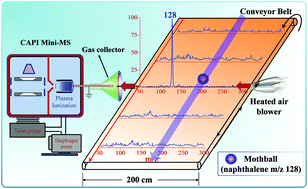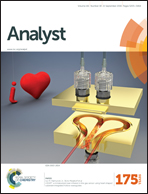An aerodynamic assisted miniature mass spectrometer for enhanced volatile sample analysis†
Abstract
Previously, we have reported the development of a miniature mass spectrometer with a continuous atmospheric pressure interface (CAPI), and the use of it for non-volatile sample analysis, such as drugs, peptides and proteins. However due to the diffusion effects in the CAPI, especially stronger for light ions, the instrument shows low detection sensitivities for volatile samples when coupling with an atmosphere pressure chemical ionization (APCI) source (>ppmv). In this study, an in-vacuum plasma ionization source was designed and integrated into the system. By performing ionization in the first vacuum stage, ion transfer loss through the CAPI was minimized and tens of ppbv level detection sensitivities were achieved for volatile samples. Due to its improved sensitivity, chemical source tracing was demonstrated in an indoor environment as a simple proof-of-concept example. Furthermore, an aerodynamic sampling method was developed to facilitate directional sample transfer towards the miniature mass spectrometer in an open environment. By coupling this aerodynamic method with the miniature mass spectrometer, remote chemical source sensing could be achieved at a distance of more than two meters. This aerodynamic sampling method could also be applied to other mass spectrometry instruments for enhanced sample sampling in open environments.


 Please wait while we load your content...
Please wait while we load your content...